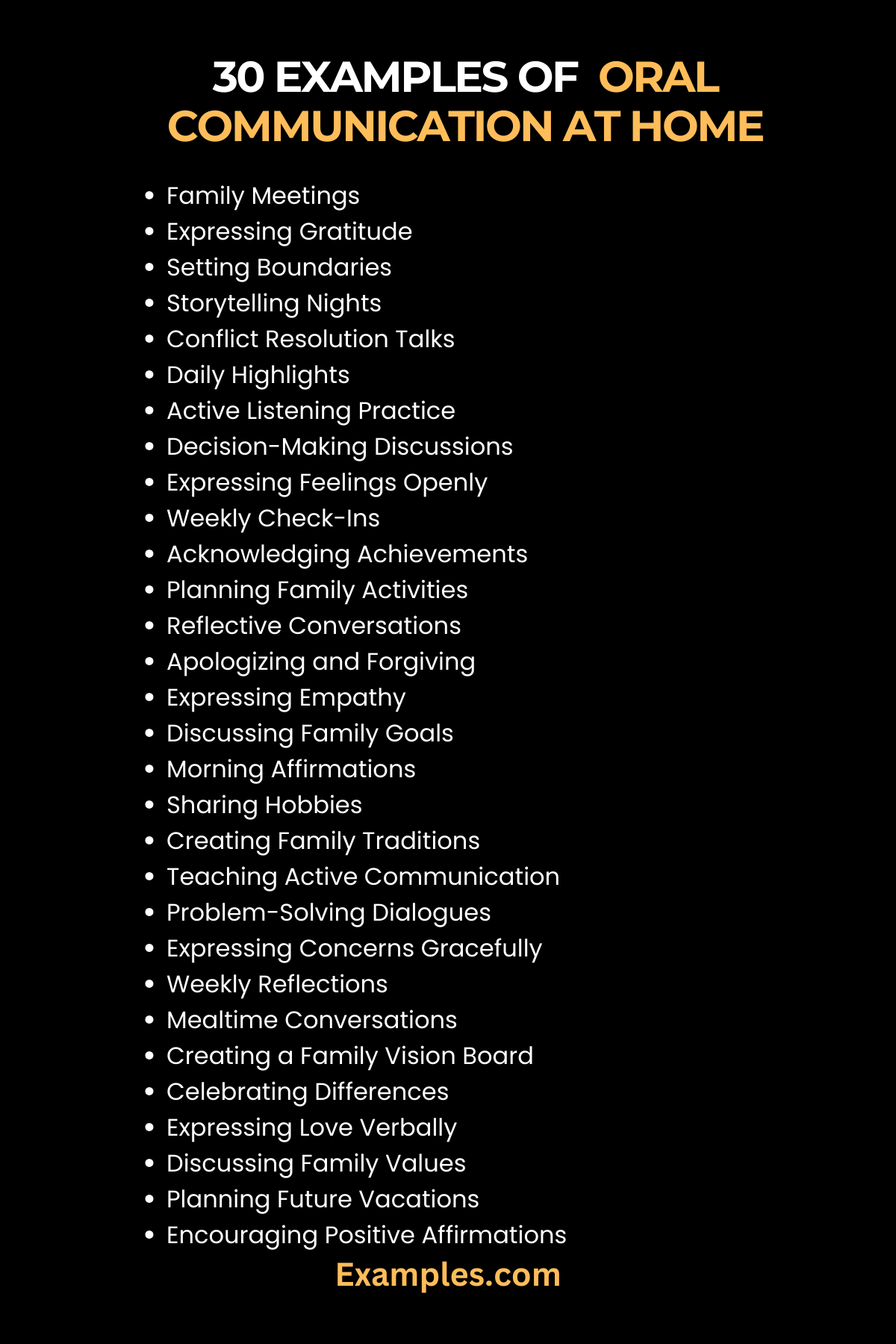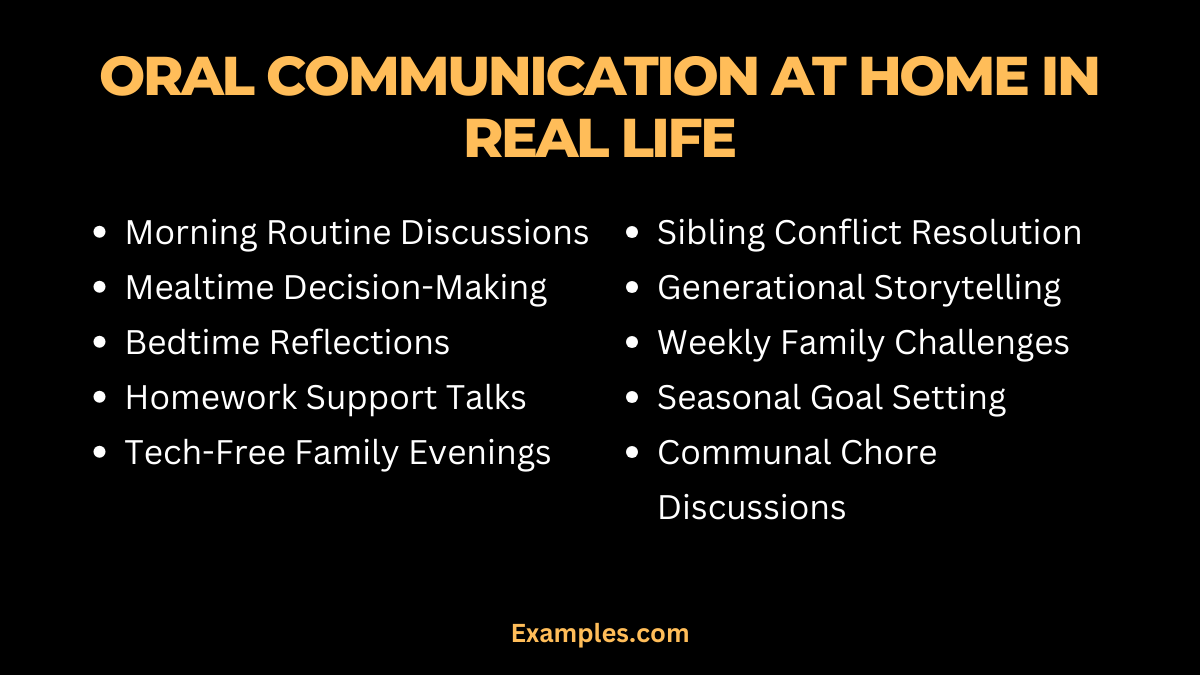Oral Communication at home
Transform your home into a haven of heartfelt connections with our comprehensive guide on Oral Communication at Home. Navigate the dynamics of family dialogue, uncovering ten positive communication rules for a thriving household. This guide goes beyond theory, providing practical Communication Examples and activities to strengthen bonds, enhance understanding, and foster an environment where every voice is heard. Elevate your family’s communication skills and create lasting memories through meaningful and engaging interactions.
What is Oral Communication at Home?
Oral Communication at Home refers to the art of exchanging thoughts, feelings, and information within a family setting through spoken words. It involves open dialogue, active listening, and the use of effective verbal expression to nurture understanding, strengthen relationships, and create a communicative atmosphere where every family member feels heard, valued, and connected. This form of communication plays a pivotal role in fostering a positive family dynamic and building a supportive environment within the home.
30 Examples of Oral Communication at Home
Explore 30 captivating Oral Communication at Home examples to elevate your family interactions. This guide goes beyond theory, offering practical and relatable scenarios that promote positive communication within your household. From resolving conflicts to expressing emotions, these examples provide actionable insights to enhance your family’s communication skills and strengthen bonds.

- Family Meetings: Foster open dialogue by holding regular family meetings, allowing each member to share thoughts and concerns.
- Expressing Gratitude: Enhance positivity by regularly expressing gratitude; for instance, say thank you for small acts of kindness.
- Setting Boundaries: Clearly communicate and respect boundaries, such as discussing privacy and personal space within the family.
- Storytelling Nights: Create memorable moments through storytelling nights, where each family member shares a favourite story or experience.
- Conflict Resolution Talks: Teach conflict resolution skills by encouraging discussions that seek understanding and compromise.
- Daily Highlights: Share daily highlights during family dinners, creating a space to celebrate achievements and discuss challenges.
- Active Listening Practice: Promote active listening skills, like paraphrasing and summarizing, to ensure everyone feels heard and understood.
- Decision-Making Discussions: Include family members in decision-making processes, teaching collaboration and respect for diverse opinions.
- Expressing Feelings Openly: Encourage openness by expressing emotions verbally, such as saying “I feel proud when you achieve your goals.
- Weekly Check-Ins: Schedule weekly check-ins to discuss individual goals, concerns, and updates, fostering a sense of unity.
- Acknowledging Achievements: Celebrate achievements with words of encouragement, reinforcing a positive and supportive family environment.
- Planning Family Activities: Use oral communication to plan and organize family activities, ensuring everyone’s preferences are considered.
- Reflective Conversations: Engage in reflective conversations, encouraging family members to share thoughts on personal growth and experiences.
- Apologizing and Forgiving: Teach the importance of apologizing and forgiving through sincere verbal communication during conflicts.
- Expressing Empathy: Cultivate empathy by expressing understanding and compassion in challenging situations, fostering emotional connections.
- Discussing Family Goals: Collaboratively set and discuss family goals, promoting a shared vision and sense of purpose.
- Morning Affirmations: Begin each day with positive oral affirmations, boosting family members’ confidence and setting a harmonious tone.
- Sharing Hobbies: Bond over shared hobbies by actively discussing interests, creating opportunities for mutual engagement.
- Creating Family Traditions: Establish verbal rituals like holiday traditions, reinforcing a sense of continuity and family identity.
- Teaching Active Communication: Model and teach active communication techniques, emphasizing eye contact, body language, and tone.
- Problem-Solving Dialogues: Encourage problem-solving dialogues, where family members collectively address and find solutions to challenges.
- Expressing Concerns Gracefully: Teach expressing concerns with tact, using phrases like “I’m concerned about…” to maintain a positive atmosphere.
- Weekly Reflections: Foster self-awareness through weekly reflections, where family members share personal insights and lessons learned.
- Mealtime Conversations: Make mealtime an opportunity for lively discussions, creating a space for sharing stories and experiences.
- Creating a Family Vision Board: Collaboratively create a vision board, using oral communication to articulate shared family aspirations and dreams.
- Celebrating Differences: Embrace diversity within the family by celebrating and discussing individual differences, fostering acceptance.
- Expressing Love Verbally: Strengthen emotional bonds by verbally expressing love and appreciation regularly within the family.
- Discussing Family Values: Reinforce family values through open discussions, ensuring a shared understanding of what matters most.
- Planning Future Vacations: Involve everyone in planning future vacations, encouraging excitement and anticipation through verbal communication.
- Encouraging Positive Affirmations: Boost self-esteem by incorporating positive affirmations into daily conversations, creating a nurturing family environment.
10 Positive Family Communication Rules for Your Home
Establishing positive family communication rules fosters a harmonious environment. These guidelines promote understanding, empathy, and strengthen familial bonds. Dive into ten empowering rules that create a foundation for open dialogue, mutual respect, and lasting connections within your home.

- Active Listening Rule: Practice attentive listening without interruptions, ensuring each family member feels acknowledged and understood.
- Express Gratitude Daily: Instil a culture of gratitude by sharing appreciations during family time, fostering positivity and appreciation.
- Embrace Open Dialogue: Encourage open and honest communication, creating a safe space for family members to express thoughts and feelings.
- Constructive Conflict Resolution: Teach problem-solving skills, emphasizing calm discussions and finding resolutions collaboratively during conflicts.
- Limit Screen Time Interruptions: Set boundaries on screen time during family interactions, promoting focused and quality communication without distractions.
- Celebrate Achievements Together: Share and celebrate individual and collective achievements, reinforcing a sense of shared success and joy.
- Establish Family Meetings: Schedule regular family meetings to discuss goals, plans, and concerns, promoting collaboration and unity.
- Model Respectful Communication: Lead by example, demonstrating respectful communication to guide family members in expressing themselves courteously.
- Create a “No Judgment” Zone: Foster a non-judgmental environment, ensuring family members feel comfortable sharing thoughts without fear of criticism.
- Encourage Empathy: Cultivate empathy by considering others’ perspectives and emotions, teaching family members to understand and support one another.
Oral Communication at Home in Real Life
Dive into the practical realm of oral communication at home, where theories meet reality. Explore real-life scenarios and examples that showcase the application of effective communication strategies within the familial setting, creating a vibrant and connected home environment.

- Morning Routine Discussions: Start the day with family discussions on daily plans, setting a positive tone for effective communication.
- Mealtime Decision-Making: Involve everyone in deciding meals, teaching collaborative decision-making and active participation.
- Bedtime Reflections: Create a nightly routine for family reflections, fostering open communication about the day’s highlights and challenges.
- Homework Support Talks: Assist with homework while discussing challenges, providing guidance and encouraging a supportive learning environment.
- Tech-Free Family Evenings: Designate certain evenings for tech-free family time, promoting face-to-face communication and shared activities.
- Sibling Conflict Resolution: Mediate and guide siblings in resolving conflicts, emphasizing compromise and understanding.
- Generational Storytelling: Share family stories across generations, creating a strong sense of identity and fostering intergenerational communication.
- Weekly Family Challenges: Introduce weekly challenges that require collaborative problem-solving, promoting teamwork and effective communication.
- Seasonal Goal Setting: Set and discuss family goals for each season, ensuring everyone has a say in the family’s aspirations and plans.
- Communal Chore Discussions: Allocate chores through family discussions, ensuring everyone contributes and feels a sense of responsibility in maintaining the household.
What are the 10 oral communication activities?
Oral communication at home plays a pivotal role in fostering strong family bonds. Explore these ten engaging activities designed to enhance communication skills and promote meaningful interactions within your household. From storytelling to conflict resolution, these activities create a positive and communicative atmosphere, ensuring every family member feels heard and valued.
- Family Storytelling Nights: Encourage each family member to share a story, fostering creativity, and strengthening oral expression skills.
- Expressive Dinner Conversations: Make mealtime a platform for open discussions, allowing family members to express thoughts, opinions, and daily experiences.
- Conflict Resolution Role-Play: Engage in role-playing scenarios to practice effective conflict resolution skills in a safe and constructive environment.
- Gratitude Circle: Form a circle and take turns expressing gratitude, promoting a positive and appreciative atmosphere within the family.
- Collaborative Decision-Making Games: Play games that involve decision-making, encouraging family members to discuss and decide collectively.
- Family Meeting Brainstorming: Conduct regular family meetings where everyone contributes ideas and suggestions for shared goals and plans.
- Weekly Reflection Journal: Introduce a weekly reflection journal for each family member to write about their experiences, fostering introspection and communication.
- Generational Interview Sessions: Encourage different generations in the family to interview each other, promoting intergenerational understanding and communication.
- Tech-Free Bonding Evenings: Designate specific evenings without electronic devices, creating a tech-free environment for face-to-face communication.
- Empathy Building Activities: Incorporate activities that focus on understanding and empathizing with each other’s perspectives and emotions.
In conclusion, effective oral communication within the home is essential for creating a nurturing and supportive environment for all family members. It involves more than just exchanging words; it’s about understanding and empathy, active listening, and mutual respect. Implementing the strategies and activities discussed in the article, such as regular family meetings, expressing gratitude, and engaging in conflict resolution talks, can significantly enhance family dynamics. These practices help in building stronger relationships and fostering a positive and communicative atmosphere at home.
For further exploration into this topic, the American Psychological Association (APA) offers a wealth of resources on family communication. Their insights on family dynamics and interpersonal relationships can provide additional strategies and tips for improving communication within the family. You can access these resources at APA’s website on family topics.
Additionally, understanding the impact of communication on mental health is crucial. The National Institute of Mental Health provides comprehensive resources on how effective communication can influence mental well-being within a family setting. These resources offer guidance on how to foster a healthy communicative environment, which is vital for the mental health of all family members. You can explore these resources at NIMH’s website on caring for your mental health.
By incorporating these resources and continuously working on communication skills, families can create a more harmonious, understanding, and supportive home environment.



